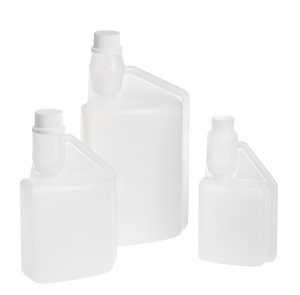
In 2021, the dosing bottles market was valued at slightly over US$ 8 billion, with projections indicating a slight increase to US$ 8.3 billion in 2022. Anticipated growth from 2022 to 2032 suggests the market will experience a surge at a Compound Annual Growth Rate (CAGR) of 4%, ultimately reaching US$ 12.3 billion. This trajectory underscores the steady expansion of the market, driven by factors such as increasing demand for precise dosing solutions in pharmaceuticals and healthcare, advancements in bottle design and materials, and the growing popularity of dosing bottles in various industries worldwide.
Dosing bottles have gained huge traction in recent times. This is owing to its increasing use in end user sectors such as pharmaceutical, chemical, automotive and industrial. The use of dosing bottles ensures accuracy and precision while liquid transmission and helps in avoiding spilling of liquids.
Request Sample: https://www.futuremarketinsights.com/reports/sample/rep-gb-2231
Dosing bottles market – Major Players
Some of the major players identified across the globe in the dosing bottles market are Cambrian Containers, Bettix Ltd, NilocG Aquatics, The Cary Company, Aquarium Plant Food UK, iBottles, United States Plastic Corporation, Industrial Container and Supply Company and Pont Europe.
Business Growth Drivers:
- Increasing Demand for Personal Care Products: The growing demand for personal care products such as shampoos, lotions, and cosmetics has led to an increased need for dosing bottles to package and dispense these products efficiently.
- Rise in Pharmaceutical Industry: The pharmaceutical industry relies heavily on dosing bottles for the packaging of liquid medications, syrups, and other formulations. With the increasing prevalence of chronic diseases and the global population aging, there’s a rising demand for pharmaceutical products, thus driving the need for dosing bottles.
- Expansion of Food and Beverage Sector: Dosing bottles are widely used in the food and beverage industry for packaging sauces, dressings, oils, and other liquid products. As consumer preferences shift towards convenience and on-the-go consumption, the demand for these products packaged in dosing bottles is expected to rise.
- Technological Advancements: Innovations in bottle design, materials, and manufacturing processes have improved the functionality, durability, and aesthetics of dosing bottles. This has expanded their application across various industries and enhanced their appeal to consumers.
- Growing Awareness of Sustainable Packaging: There’s a growing awareness among consumers and businesses about the environmental impact of packaging materials. Dosing bottles made from recyclable materials and those designed for reusability are becoming increasingly popular, driving growth in this segment.
- E-commerce Boom: The rise of e-commerce has significantly increased the demand for packaging solutions, including dosing bottles. These bottles need to be lightweight, durable, and leak-proof to withstand the rigors of shipping and handling during transit.
Industry Restraints:
- Cost of Raw Materials: Fluctuations in the prices of raw materials such as plastics, glass, and metals can impact the production costs of dosing bottles. Instability in raw material prices can pose challenges for manufacturers in maintaining profitability.
- Regulatory Compliance: Compliance with stringent regulations and standards related to packaging materials, safety, and labeling can be a significant challenge for dosing bottle manufacturers. Meeting these requirements adds to the production costs and may constrain market growth.
- Competition from Alternative Packaging Formats: Dosing bottles face competition from alternative packaging formats such as pouches, sachets, and tubes, especially in certain sectors like the cosmetics and personal care industry. These alternatives may offer different advantages in terms of convenience, cost, or environmental footprint, posing a challenge to the growth of dosing bottles.
- Limited Shelf Life: Dosing bottles, particularly those made from certain materials, may have limitations in terms of shelf life for certain products, especially those that are sensitive to light, oxygen, or moisture. This can restrict their use in certain applications and industries.
- Supply Chain Disruptions: Disruptions in the supply chain, whether due to natural disasters, geopolitical factors, or other unforeseen events, can impact the availability of raw materials and components needed for manufacturing dosing bottles. Such disruptions can lead to delays in production and distribution, affecting market growth.
Buy Now/Purchase: https://www.futuremarketinsights.com/checkout/2231
Dosing bottles market- Market Segmentation
The global dosing bottles market is segmented on the basis of product type, package type, material type and application type. On the basis of product type, global dosing bottles market is segmented into single neck dosing bottle and twin neck dosing bottle, wherein, twin neck dosing bottle is expected to account for more than half of the total market value and volume share.
About Future Market Insights (FMI)
Future Market Insights, Inc. (ESOMAR certified, recipient of the Stevie Award, and a member of the Greater New York Chamber of Commerce) offers profound insights into the driving factors that are boosting demand in the market. FMI stands as the leading global provider of market intelligence, advisory services, consulting, and events for the Packaging, Food and Beverage, Consumer, Technology, Healthcare, Industrial, and Chemicals markets. With a vast team of ~400 analysts worldwide, FMI provides global, regional, and local expertise on diverse domains and industry trends across more than 110 countries.
Contact Us:
Future Market Insights Inc.
Christiana Corporate, 200 Continental Drive,
Suite 401, Newark, Delaware – 19713, USA
T: +1-845-579-5705
For Sales Enquiries: sales@futuremarketinsights.com
Website: https://www.futuremarketinsights.com
LinkedIn| Twitter| Blogs | YouTube




